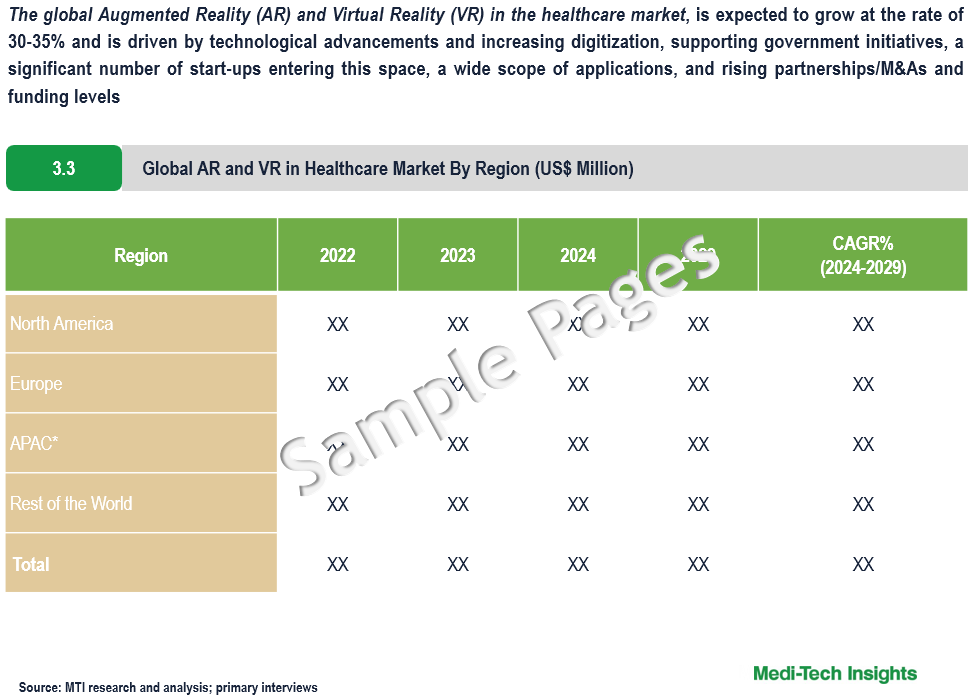
Augmented Reality (AR) and Virtual Reality (VR) in Healthcare Market Size, Growth, and Technological Advancements for Forecast 2029

The global Augmented Reality (AR) and Virtual Reality (VR) in the healthcare market, is expected to grow at the rate of 30-35% and is driven by technological advancements and increasing digitization, supporting government initiatives, a significant number of start-ups entering this space, a wide scope of applications, and rising partnerships/M&As and funding levels. To learn more about the research report, download a sample report.
AR technology augments the real world, adding additional data, whereas VR is a simulated, fully digital, computer-generated, 3D experiential environment. While AR and VR technologies were initially exclusively adopted by the gaming industry, various sectors including healthcare are increasingly recognizing its benefits and exploring the prospects of AR/VR for medical applications.
Significant Potential for AR and VR in Healthcare Market
AR and VR in healthcare, currently a niche market, present tremendous growth potential. These technologies are being utilized in a variety of applications including medical training, surgical planning, pain management, patient care management, emergency treatment, post-traumatic stress treatment, and mental health therapy. Additionally, VR is proving valuable in the timely detection of Alzheimer’s disease and in identifying early signs of schizophrenia. For instance,
- In October 2023, Surgical Theater announced that Stanford Medicine performed the first spine surgery using its augmented reality technology, SyncAR® Spine, integrated with Microsoft HoloLens headsets, marking a significant milestone in their partnership for advancing XR surgical care
- In March 2022, CAE Healthcare released an enhanced CathLabVR cardiac training tool featuring an updated percutaneous coronary intervention (PCI) module that leverages mixed reality to teach coronary angioplasty and stenting techniques, offering over 31,000 unique scenarios for practicing the treatment of coronary blockages and heart attacks.
- Founded in 2020, Rey offers online VR-based therapeutic sessions for mental health management
The scope of AR and VR applications in healthcare is expanding rapidly, driven by the increasing number of startups entering the space. These startups are offering a diverse range of hardware and software solutions tailored to different areas of healthcare. Innovations in this field are not only enhancing the effectiveness of existing treatments but are also paving the way for new therapeutic approaches.
“The potential of AR and VR in healthcare is huge. Companies in this advanced technology field are constantly striving to surpass the challenges by developing accurate and explicit solutions that enable breakthroughs in the way treatment and diagnosis is done in the medical field.” - Chief Executive, Provider of AR Platform for Surgery Guidance, US
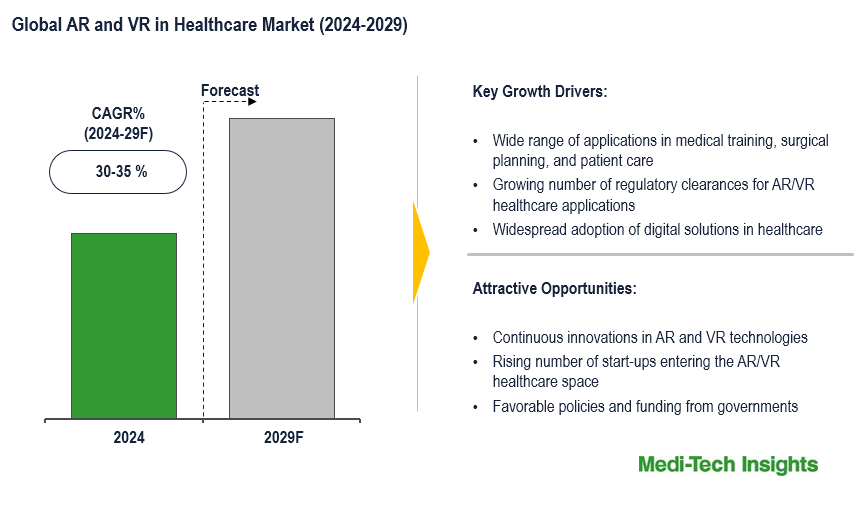
To learn more about this report, download the PDF brochure
Transforming Healthcare with AR and VR Technologies
Health is undergoing a revolution with augmented reality (AR) and virtual reality (VR) at the forefront, transforming surgical training, patient care, and mental health treatment. AR and VR offer unparalleled precision, immersion, and connectivity, enhancing medical education through hyper-realistic simulations and real-time 3D visual overlays during surgeries. These technologies also revolutionize 3D medical imaging, allowing detailed examination of complex structures for accurate diagnoses and personalized treatment.
Integrating AR and VR with AI and machine learning will enable more personalized and adaptive healthcare solutions, playing a crucial role in telemedicine and remote care by providing innovative ways to deliver services. Wearable AR devices will facilitate continuous health monitoring and real-time interventions, especially for managing chronic conditions. The rapid development and adoption of AR and VR in healthcare signal a promising future where these tools become integral to medical practice, enhancing training, diagnostics, treatment, and overall patient care. As the market grows, ongoing research and development will continue to unlock new applications and improve healthcare delivery. For instance,
- In December 2022, Microsoft introduced HoloLens 2 a suite of advanced, immersive collaboration tools specifically designed to enhance the experiences of industrial metaverse customers, enabling more effective and interactive virtual interactions within their respective fields
Remote patient monitoring with AR and VR breaks geographical barriers, ensuring continuous care through real-time guidance and remote procedures. In mental health, AR and VR offer innovative therapeutic solutions for conditions like loneliness, addiction, and depression by providing immersive and safe treatment environments. Additionally, these technologies make exercise more engaging and accessible through gamified virtual workouts and fitness apps. Overall, AR and VR are poised to revolutionize healthcare by enhancing patient care and provider capabilities.
Surging VC/PE Investments and Regulatory Approvals Accelerating Growth & Innovation in AR and VR in Healthcare Market
The Covid-19 pandemic induced the world to go virtual. The last couple of years have marked a turning point with several hyped technologies like AR/VR finally becoming a reality in healthcare, backed by surging VC investments and regulatory clearances. Some of the key recent developments in this market include:
- In July 2023, Proprio announced securing $43 million in Series B funding from new and existing investors to support the commercialization of its AI-driven surgical navigation platform, meeting significant demand in the US and internationally
- In February 2022, MindMaze announced securing a $105 million financing round led by Concord Health Partners to accelerate its global commercial growth, enhance ongoing R&D, and strengthen the clinical development pipeline of its pioneering digital therapeutic solutions for various neurological diseases
- In Nov 2021, the FDA approved AppliedVR’s EaseVRx, a prescription-use immersive virtual reality (VR) system for chronic pain reduction
- In May 2021, Heru, Inc., a US-based developer of wearable AI-powered vision diagnostics and augmentation software, raised $30m in Series A funding
Regional Outlook – North America Leads the Adoption While EU is Not Far Behind
North America dominates the AR/VR in the healthcare market and is expected to witness fastest growth in the next 5 years. Major factors that are driving growth in this region are supporting healthcare IT infrastructure, greater adoption of advanced technologies, significant VC fundings, presence of large number of AR/VR companies/startups in the US and favorable government initiatives. For instance, The National Institute of Health of the U.S. government is offering funds for research in virtual reality in healthcare. Moreover, The Medical Extended Reality Program in the FDA’s Center for Devices and Radiological Health (CDRH) conducts regulatory science research to help ensure patient access to innovative extended reality-based devices that are safe and effective.
Lack of VR and AR skilled professionals is a challenge in Europe but this region is catching up fast and countries like France, Germany, UK, Sweden, Netherlands and Italy are likely to offer vast growth opportunities for AR and VR in healthcare. As a part of its digital strategy, in 2020, the European Commission launched “The Virtual and Augmented Reality Industrial Coalition”, a platform for structured dialogue between the European VR/AR ecosystem and policymakers. Moreover, Germany’s ERDF-funded ‘Healthy Reality’ project is exploring how AR/VR can be used to improve healthcare in terms of new treatments, therapies and teaching methods.
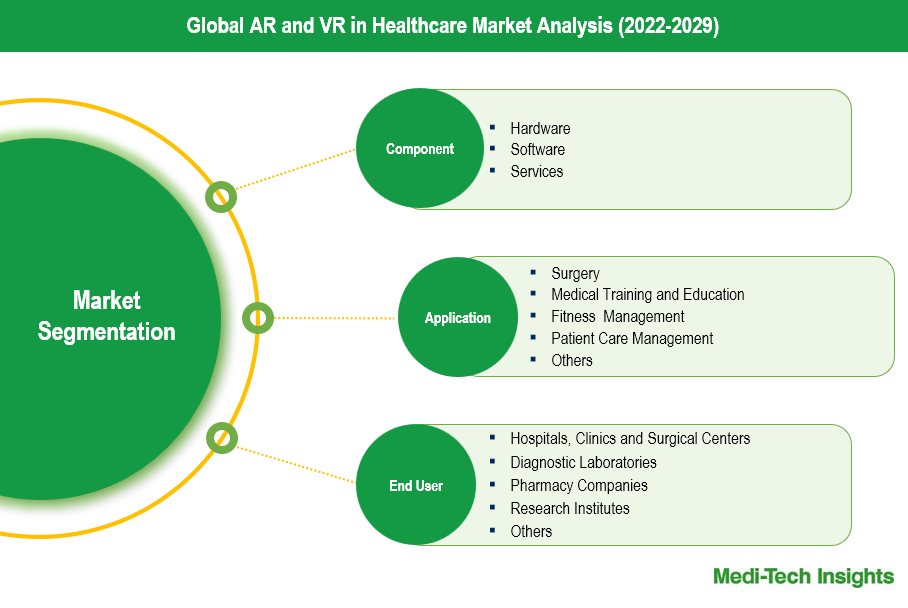
To learn more about this report, download the PDF brochure
Application Segment Outlook
The global Augmented Reality (AR) and Virtual Reality (VR) in the healthcare market are experiencing significant growth across various application segments, driven by technological advancements and increasing adoption. In the surgery segment, AR and VR technologies are transforming surgical procedures by providing real-time 3D visual overlays and enhanced precision, significantly reducing operation times and improving outcomes. This segment holds a considerable market share due to its critical role in advancing surgical capabilities. In medical training and education, AR and VR are revolutionizing the way medical professionals are trained by offering hyper-realistic simulations and interactive learning environments, allowing for the safe practice of complex procedures without risking patient safety. This segment also commands a substantial market share, reflecting the high demand for innovative training solutions. Fitness management benefits from VR through gamified virtual workouts and fitness apps, making exercise more engaging and accessible. Although it represents a smaller portion of the market, its growth is notable as it aligns with the increasing focus on preventive healthcare and wellness. Patient care management utilizes AR for remote patient monitoring, real-time interventions, and immersive therapeutic environments for conditions like chronic pain, PTSD, and mental health disorders. This segment is rapidly expanding, driven by the need for continuous and comprehensive patient care, and it captures a significant market share due to its broad application scope and potential to enhance patient outcomes.
The market share distribution among these segments is influenced by the technological maturity and adoption rates within healthcare institutions. Surgical applications and medical training lead in market share, while fitness management, patient care management and other segments are quickly catching up as the technology becomes more widely adopted and integrated into various aspects of healthcare delivery.
End-User Segment Outlook
The global Augmented Reality (AR) and Virtual Reality (VR) in the healthcare market end-users segment includes hospitals, clinics, surgical centers, diagnostic laboratories, pharmacy companies, and research institutes among others. Hospitals, clinics, and surgical centers dominate the market share due to their extensive use of AR and VR technologies in surgical planning, real-time navigation during procedures, and enhanced patient care management. These institutions are early adopters, leveraging AR and VR to improve surgical outcomes, train medical staff, and offer immersive patient care solutions. Diagnostic laboratories are also significant users, utilizing AR and VR for advanced imaging techniques, precise diagnostics, and streamlined laboratory workflows, thereby holding a notable market share. Pharmacy companies are increasingly adopting AR and VR to enhance drug development processes, from molecular modeling to simulating drug interactions, as well as to create immersive educational tools for pharmacists and patients, contributing to a growing share of the market. Research institutes leverage AR and VR for innovative medical research, clinical trials, and the development of new therapeutic techniques, facilitating breakthroughs in medical science and maintaining a substantial market presence. These institutes use AR and VR to simulate complex biological processes and visualize experimental outcomes, which enhances their research capabilities and accelerates the pace of discovery. Overall, hospitals, clinics, and surgical centers lead the market share due to their comprehensive use of AR and VR technologies, followed by diagnostic laboratories and pharmacy companies, with research institutes playing a crucial role in driving innovation and expanding the applications of these technologies in healthcare.
Competitive Landscape: Augmented Reality (AR) and Virtual Reality (VR) in Healthcare Market
The global AR and VR in healthcare market is highly competitive and fragmented. Some of the key and emerging players in this market include CAE Healthcare, GE Healthcare, Philips Healthcare, Microsoft, Siemens Healthineers, Intuitive Surgical, Psious, MindMaze, Virtualis, Oxford VR, Augmedics, Surgical Theater, EchoPixel, Medivis, Health Scholars, Vicarious Surgical, Touch Surgery, Propio Vision, Immersive Touch, OSSO VR, SentiAR, Medical Augmented Intelligence, SyncThink, XRHealth, and Karuna Labs among several others.
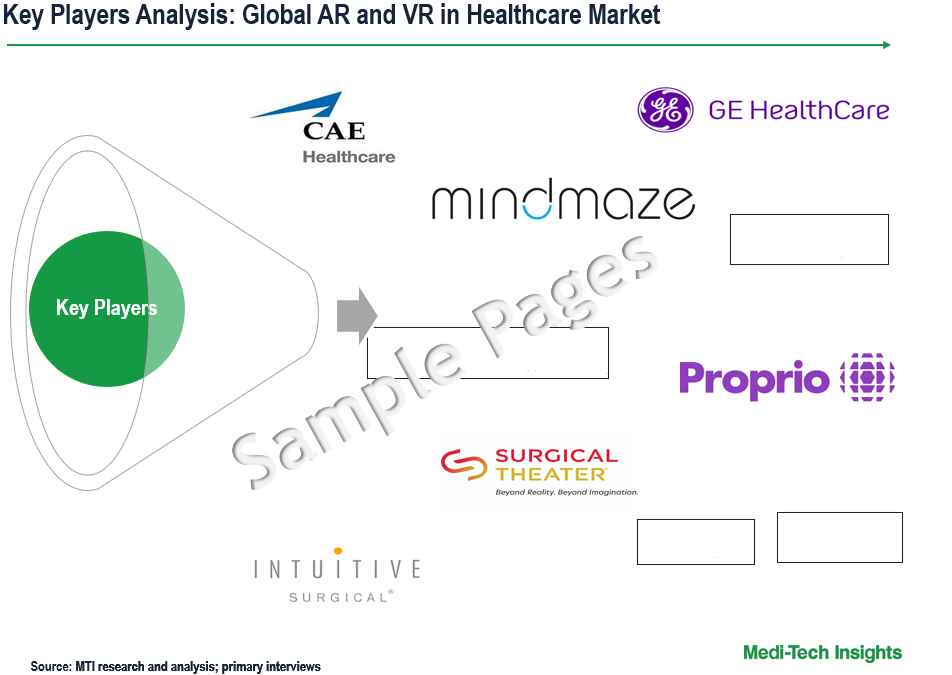
Get a sample report for competitive landscape analysis
Organic and Inorganic Growth Strategies Adopted by Players to Establish Their Foothold in the Market
Players operating in this market are adopting both organic and inorganic growth strategies such as collaborations, acquisitions, and new product launches to garner market share. For instance,
- In April 2024, Proprio and Biedermann Group announced a strategic partnership to integrate advanced spinal implants with Proprio’s AI-powered Paradigm system, aiming to revolutionize spine surgery with real-time visualization and guidance
- In January 2024, GigXR Inc. and CAE Healthcare announced their partnership to enhance clinical simulation efficiency and effectiveness by integrating multimodal simulation techniques, including analog, immersive, and digital modalities, for diverse healthcare training environments, and will showcase their collaboration at IMSH 2024
- In December 2022, MindMaze and Vibra Healthcare announced a partnership to implement MindMaze’s digital health technology platform (MindPod® and MindMotion®GO) in select Vibra hospitals in Kentucky and California, aiming to enhance neurotherapeutic patient care both in-clinic and at-home for conditions like Stroke/TBI, SCI, and Parkinson’s Disease, by offering significantly higher dosages and intensity levels of interventions than current standards
- In November 2022, GE Healthcare and MediView XR, Inc. announced their collaboration to integrate medical imaging into mixed reality solutions with the development of the OmnifyXRTM Interventional Suite System, aiming to enhance precision care through augmented reality visualization, remote collaboration, and evidence-based insights
- In April 2021, Medtronic plc and Surgical Theater announced a partnership to integrate Surgical Theater's SyncAR™ augmented reality technology with Medtronic's StealthStation™ S8 surgical navigation system, enhancing neurosurgeons' real-time visualization and planning during complex cranial procedures with 360° AR renderings
The global AR and VR in Healthcare market is expected to gain further momentum in the coming years due to technological advancements, favourable government initiatives, a significant number of start-ups entering the space, a wide scope of applications, and aggressive organic and inorganic growth strategies followed by the players.
Augmented Reality & Virtual Reality In Healthcare Market Futures and Scope
| Report Scope | Details |
| Base Year Considered | 2023 |
| Historical Data | 2022 - 2023 |
| Forecast Period | 2024 - 2029 |
| CAGR (2024 - 2029) | 30-35% |
| Segment Scope | Product, Delivery Mode, and End User |
| Regional Scope |
|
| Key Companies Mapped | CAE Healthcare, GE Healthcare, Philips Healthcare, Microsoft, Siemens Healthineers, Intuitive Surgical, Psious, MindMaze, Virtualis, Oxford VR, Augmedics, Surgical Theater, EchoPixel, Medivis, Health Scholars, Vicarious Surgical, Touch Surgery, Propio Vision, Immersive Touch, OSSO VR, SentiAR, Medical Augmented Intelligence, SyncThink, XRHealth, and Karuna Labs among others |
| Report Highlights | Market Size & Forecast, Growth Drivers & Restraints, Trends, Competitive Analysis |
Key Strategic Questions Addressed
-
What is the market size & forecast for the Global AR and VR in Healthcare Market?
-
What are the historical, present, and forecasted market shares and growth rates of various segments and sub-segments of the Global AR and VR in Healthcare Market?
-
How has COVID-19 impacted the Global AR and VR in Healthcare Market?
-
What are the major growth drivers, restraints/challenges impacting the market?
-
What are the opportunities prevailing in the market?
-
What is the investment landscape?
-
Which region has the highest share in the global market? Which region is expected to witness the highest growth rate in the next 5 years?
-
Who are the major players operating in the market? What is the competitive positioning of key players?
-
Who are the new players entering the market?
-
What are the key strategies adopted by players?
- Research Methodology
- Secondary Research
- Primary Research
- Market Estimation
- Market Forecasting
- Executive Summary
- Market Overview
-
- Market Dynamics
- Drivers
- Restraints
- Key Market Trends
- Industry Speaks
- Market Dynamics
- Key Revenue Pockets
- Global AR and VR in Healthcare Market - Size & Forecast (2021-2028), By Component
- Hardware
- Software
- Services
- Global AR and VR in Healthcare Market - Size & Forecast (2021-2028), By Application
- Surgery
- Medical Training and Education
- Fitness Management
- Patient Care Management
- Others
- Global AR and VR in Healthcare Market - Size & Forecast (2021-2028), By End User
- Hospitals
- Clinics
- Surgical Centers
- Diagnostic Laboratories
- Research Institutes
- Pharmacy Companies
- Others
- Global AR and VR in Healthcare Market - Size & Forecast (2021-2028), By Region
- North America (U.S. & Canada)
- Europe (UK, Germany, France, Italy, Spain, Rest of Europe)
- Asia Pacific (China, India, Japan, Rest of Asia Pacific)
- Rest of the World (Latin America, Middle East & Africa)
- Competitive Landscape
- Key Players and their Competitive Positioning
- Competitive Positioning of Key Players (2022)
- Offerings Assessment, By Player
- Key Strategies Assessment, By Player (2021-2023)
- New Product & Service Launches
- Partnerships, Agreements, & Collaborations
- Mergers & Acquisitions
- Geographic Expansion
- Key Players and their Competitive Positioning
- Key Companies Scanned (Indicative List)
- CAE Healthcare
- GE Healthcare
- Philips Healthcare
- Microsoft
- Siemens Healthineers
- Intuitive Surgical
- Psious
- MindMaze
- Virtualis
- Oxford VR
- Augmedics
- Surgical Theater
- EchoPixel
- Medivis
- Health Scholars
- Vicarious Surgical
- Touch Surgery
- Propio Vision
- Immersive Touch
- OSSO VR
- SentiAR
- Medical Augmented Intelligence
- SyncThink
- XRHealth
- Karuna Labs
- Other Prominent Players
The study has been compiled based on extensive primary and secondary research.
Secondary Research (Indicative List)
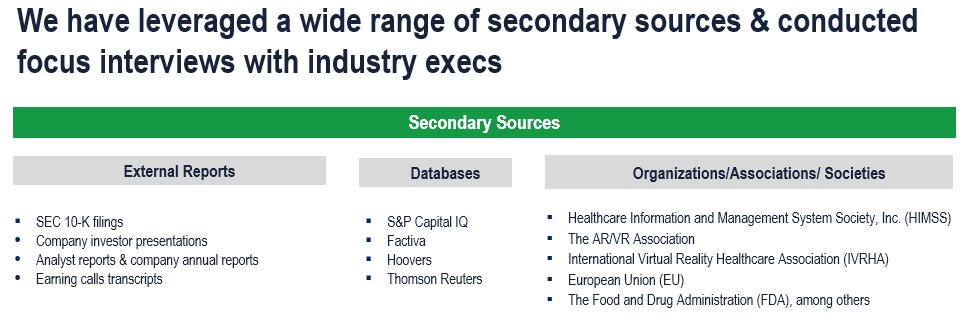
Primary Research
To validate research findings (market size & forecasts, market segmentation, market dynamics, competitive landscape, key industry trends, etc.), extensive primary interviews were conducted with both supply and demand-side stakeholders.
Supply Side Stakeholders:
- Senior Management Level: CEOs, Presidents, Vice-Presidents, Directors, Chief Technology Officers, Chief Commercial Officers
- Mid-Management Level: Product Managers, Sales Managers, Brand Managers, Business Development Managers, Consultants
Demand Side Stakeholders:
- Stakeholders in Hospitals, Diagnostic Centers, Public Health Agencies, Behavioral/Mental Health Centers, Rehabilitation Centers, Medical Device Companies & Other End Users
Breakdown of Primary Interviews
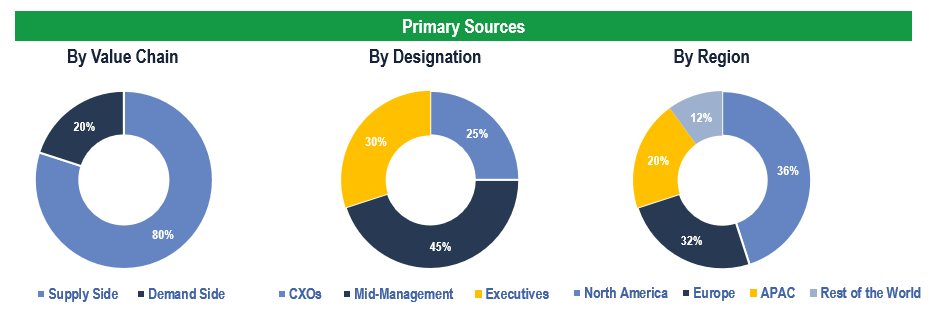
Market Size Estimation
Both ‘Top-Down and Bottom-Up Approaches’ were used to derive market size estimates and forecasts.
Data Triangulation
Research findings derived through secondary sources & internal analysis were validated with Primary Interviews, Internal Knowledge Repository, and Company Sales Data.

